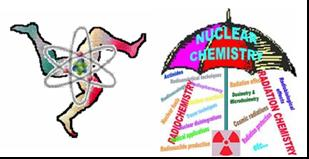Speaker
Mr
Dag Eriksen
(Primus.inter.pares AS, Norway)
Description
Nuclear technology utilizes several stable nuclides, but not necessarily as isotopically pure materials. One example is boron, where B-10, abundance 19.9%, has a high thermal neutron absorption cross section utilized in neutron detectors, but natural boron is used despite the fact that the 80.1% abundant B-11 is not contributing. In Generation IV-reactor concepts fuels sustaining high temperatures are essential. One of the most interesting concepts is the Pebble Bed Modular Reactor where a small kernel of UO2 (or other fuel compound) is coated with ceramic materials. The fuel is called Triso (triply coated ceramic particle fuel) and is designed for being used for a long time and then disposed off. One of the coatings is SiC. In natural silicon a portion will transform to phosphorous during neutron bombardment. Phosphorous in SiC makes the material brittle and is undesirable. Removing the two heavier isotopes in Si makes the probability for getting (n,gamma)-reactions leading to P-31 unlikely. The challenge has therefore been to develop a low cost enrichment process for Si-28. The Norwegian company Isosilicon AS is devoted to this task and has developed a process based on the silicon gas silane, SiH4. The abundances of the silicon isotopes are 92.223, 4.685, and 3.092% for Si-28, Si-29, and Si-30, respectively. Thus, the challenge is to remove the two heavier isotopes. We initially developed a diffusion based process through a chromatography column packed with monodispersed polymer spheres. We achieved a separation factor between Si-28 and 30Si of 1.10 at a yield of 0.7%. The drawback of the method was too low throughput, and forming a collaboration with the French company Novasep SA an improved method was developed. In this process a column packed with a zeolite is used. The zeolite acts as an absorbent and when silane is passing through the column the heavier silicon isotopes are retained or exchanged with Si-28 on the column. Separation factors between Si-28 and Si-30 of 1.15 have been achieved, but at a smaller yield.
Author
Mr
Dag Eriksen
(Primus.inter.pares AS, Norway)
Co-authors
Dr
Bruno Ceccaroli
(Isosilicon AS, Norway)
Dr
Pierre Hilaireau
(Stonedge SA, Luxembourg)
Dr
Wieslaw Majevski
(Novasep SA, France)
